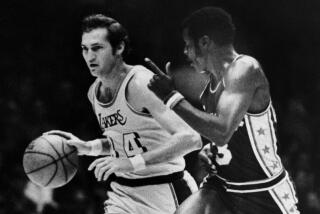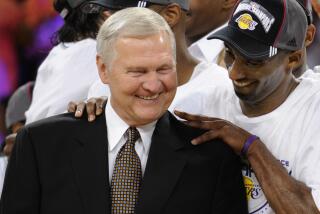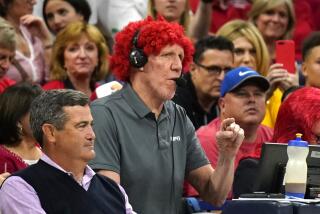Chamberlain Reflects Upon a Different Brand of Basketball
- Share via
Wilt Chamberlain, a youthful bounce in his step, glides into a crowded restaurant and slips between the tables with a supple ease that belies his 7-foot 1-inch frame.
His presence is still as imposing as the numbers he etched in the record books of professional basketball.
And at 49, he still looks much as he did when he patrolled the lanes in the 1960s and early 1970s, a ferocious center known for thundering dunks, crashing rebounds and incredible stats.
But the game he played, the game he still follows closely, is a far cry from the game he so dominated until his retirement 12 years ago.
“It is a run-up-and-down-the-court-and-dunk game. These are speed merchants and jumping fools. That’s why their shooting percentages are going way up,” he says of today’s National Basketball Assn. players.
“I led the league 11 times in field goal percentage and my lifetime average was 54%. There are five billion guys out there now shooting over 54%.”
Changed, too, are the playing conditions.
“Can you imagine playing when your hands are so cold and the ball is hard as a brick?’ asks Chamberlain, an animated storyteller.
“I can remember going to Detroit and playing in the old Detroit Arena and there’s about 3,000 people in this big old huge thing. Every time they opened the door, the wind blows through.
“I can remember vividly Paul Arizin, who was one of the greatest basketball players ever to play the game, going like this (he blows into his hands as if to warm them) . . . and the smoke is blowing out of his nose.
“Guys were shooting 37%, these were great shooters,” he said. “People look at that and say, ‘Is that a basketball player or was he on a blind team.’
“They don’t know how to put that into perspective. It makes a big difference.”
Another big difference is travel.
“We traveled and played on the same day,” Chamberlain said. “How about flying out at 7 o’clock in the morning and flying to Los Angeles. You can fly all day long and play at night.
“And we flew coach . . . big 7-footers sitting up there like this (He brings his knees to his chest). ‘Hi, Wilt, Let’s play some cards. OK, sure.’ Can you imagine that?”
Chamberlain, who plays a lot of beach volleyball now, laughs heartily, reveling in the recollections.
“I wouldn’t trade my time for this, no way, no how,” he says, dismissing the present league with a wave of his hand. “They’ve built up so much the money and the hype, and they trade players around like you can’t believe.”
The NBA two decades ago was a close-knit group, he says.
“We had a closer and better time as athletes doing our job and doing our work than I think these guys do. That’s because these guys don’t know where they’re going to be tomorrow.”
In 1974, the year after he retired, Chamberlain co-authored a story in Sports Illustrated that stated: “It may not sound humble to say it, but I think my impact on basketball will be everlasting.”
He also noted that he was the first athletic 7-footer who could run the court and who was agile enough to become an offensive weapon. His statistics weren’t bad, either--100 points in a game, an average 50.4 points per game one season, and a 30.4 career scoring average.
Chamberlain smiles with satisfaction as his words are read back to him.
“I think we should put that in a time capsule and bury it,” the Hall of Famer said. “Look at all the centers they talk about. The agility of a (Ralph) Sampson or (Akeem) Olajuwon, the guys who kinetically are able to be athletes. The guys in my time were big, strong--cumbersome, if you want to use the word.
“But they played a different type of basketball game. They weren’t required to run and jump over the top of people and dunk the ball. Now, you get that type of player.
“I think that I was a little bit before my time, so therefore I had an influence,” he said. “But I also think a great many people could never fully appreciate what I was doing because there was nothing to compare it to.”
Comparisons, however, are not something Chamberlain enjoys.
“Here’s something that burns Wilt Chamberlain, that’s when I listen to these various announcers doing the color for college or pro games. They say, ‘Oh, Patrick Ewing blocked that shot like Bill Russell used to block shots.’
“These people have never seen Wilt Chamberlain or Bill Russell play basketball. They’re just parroting what they heard somebody else say.”
Chamberlain’s individual acclaim in the annals of pro basketball has been overshadowed by the Boston Celtics. During his years in the NBA, the Celtics won 11 league championships behind another intense center, Russell.
But so much has been made of Boston’s domination, Chamberlain said, that Russell’s performance has been blown out of proportion.
“You hear about all those big confrontations between Bill Russell and Wilt Chamberlain . . . there were no confrontations,” he said. “I scored more points against the Celtics than anybody else, and there were three and four people playing me, not just Bill Russell.
“Nobody really cares about that, it’s not important. But I care because it’s something that’s personal to me. We all want to get credit for what we’ve done.”
Despite the Celtics’ success, teams led by Chamberlain were carving out a record that would have been lauded in any other era. In his 14 years in the NBA, Chamberlain led his team into the playoffs 13 times, twice winning championships. The first came in 1966-67 with the Philadelphia 76ers, the second in 1971-72 with the Los Angeles Lakers.
His teams lost in the finals four other times and were beaten in the conference final six times.
But the Celtics almost always seemed to be the nemesis of Chamberlain-led teams, beating them twice in the championship series and five times in the conference finals. Three times, a series was decided by a seventh game that Boston won by either one or two points.
Chamberlain was the NBA’s all-time leading scorer until Kareem Abdul-Jabbar of the Lakers broke his mark of 31,419 on April 5, 1985 in a game with the Utah Jazz in Las Vegas.
“Kareem breaks my scoring record and he gets a brand new Mercedes, a $65,000 car,” Chamberlain says with a laugh. “This is one of 103 records that I owned and nobody ever gave me a Popsicle.”
Nevertheless, he says he’s grateful for all he did get.
“I owe everything that I have to the game of basketball,” he said. “I don’t want people to think that I in any way don’t care for basketball because I think it’s still the greatest game invented. But I had my day in the sunshine there.
“The only thing unfortunate was that it wasn’t 20 years later, so they could have it all down on videotape so people could see for themselves who blocked the most shots and how they did it. Unfortunately, all you have to go by is hearsay.”
More to Read
Go beyond the scoreboard
Get the latest on L.A.'s teams in the daily Sports Report newsletter.
You may occasionally receive promotional content from the Los Angeles Times.










